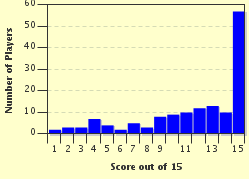Quiz Answer Key and Fun Facts
1. The fullback of the century hasn't played since the 1950s but his name lives on in Man of the Match medal awarded every year in the NRL Grand Final. With the nickname of "The Little Master" who was declared the fullback of the century?
2. One of the wingers in the Team of the Century is the first player to be inducted into both the Australian and British Rugby League Halls of Fame. This winger scored an amazing 796 tries in his career and is the only member of the Team of the Century to have never played a test match for Australia. Who is this remarkable player?
3. One of the wingers in the Team of the Century played for both the North Sydney Bears and the Manly-Warringah Sea Eagles. He scored 33 tries in 31 test matches while playing for his country. Who is this try scoring winger?
4. This centre played for St George in the 1950s and 1960s. He captained Australia for eight of the thirty-six tests he played. With the nickname of Puff, the Magic Dragon, who is this centre?
5. This selection picks himself really. He was the first player to tour four times with the Kangaroos, and the first player to make two tours as captain. He played in the first State of Origin match, and won three NRL premierships while captain. Who is this centre?
6. For the pivotal position of five-eighth we need someone who can take a leading role in his team's positional play, who can direct the attack like no one else, someone who can control a team like a king would control his realm. Who is this "royal" player chosen in the Team of the Century as the five-eighth?
7. The Australian Rugby League Team of the Century needs a halfback. The man chosen for this honour played 21 test matches, 23 State of Origins for New South Wales, and was the first player to score over 2,000 pts for a single team in the NRL premiership. Who is this agile, instinctive and daring Knights player?
8. The lock in the Australian Rugby League Team of the Century started his professional career playing for Newtown but it wasn't long before the St George Dragons lured him to their den. Our lock won eight premierships with the Dragons and secured a place in history with his endurance. Never a chicken on the field, who is he?
9. One of the second-rowers in the Australian Rugby League Team of the Century played for only two teams in his career - Eastern Suburbs and South Sydney. He also captained Australia to a World Cup win in 1970. Who is this man?
10. One of the second-rowers in the Australian Rugby League Team of the Century is memorable for his height, his indefatigability, his captain-coaching of St George to four premierships, and the nickname of "Sticks". Who is this second-rower in the ARL Team of the Century?
11. One of the front-rowers in the Australian Rugby League Team of the Century was the first indigenous Australian to captain an Australian sporting team in any sport. With a personality and sporting brain as big as his heart, who was this front-rower?
12. The Australian Rugby League Team of the Century has a front-rower who played his entire domestic career in Queensland in the post-WWII era between 1945 and 1957. Described as having the perfect combination of brawn and brains, who is this front-rower?
13. The hooker in the Australian Rugby League's Team of the Century started off his career in Ipswich (Qld) and finished it in Wollongong (NSW) in 1970. Who is this man selected as the hooker of the century?
14. Every team needs reserves (interchange players) in case of injury. The Australian Rugby League Team of the Century has four reserves - two backs and two forwards. One of the reserves is the first person to win an NRL premiership and an Ashes series as a player, a captain, and as a coach. Of the four reserves, who is the player who achieved all this?
15. The Australian Rugby League Team of the Century needs a coach! The coach elected as the best coach of the century had a sharp mind, a clever and insightful wit, and a slow, deliberate manner. He coached six teams in the NRL competition as well as the NSW State of Origin team in 1989-90. Who is this super coach?
Source: Author
Tizzabelle
This quiz was reviewed by FunTrivia editor
gtho4 before going online.
Any errors found in FunTrivia content are routinely corrected through our feedback system.

